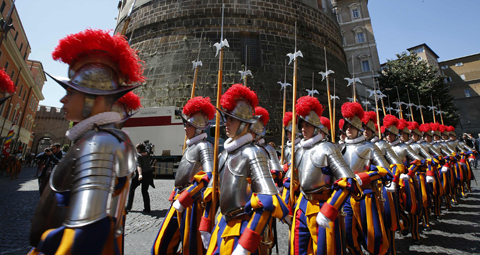BY Amanda Connelly | August 16 | ![]() 0 COMMENTS
0 COMMENTS ![]() print
print

The role of the papacy in conflict and diplomacy
John Carr, author of The Pope’s Army: The Papacy in Diplomacy and War, on why the Church is a 'shining jewel impervious to time'
Across the Catholic Church’s 2,000-year history, the papacy has stood prominently in religious, cultural, political and military spheres.
It’s history is as expansive as it is extensive, and its influence far-reaching. Writer John Carr, who has enjoyed a career as a journalist, correspondent and broadcaster, and who was previously a correspondent for The Times and The Wall Street Journal Europe, has published his eighth book for Pen & Sword, The Pope’s Army: the Papacy in Diplomacy and War, detailing an extensive papal history from its earliest days until the papacy of Pope Francis.
While this is a newly published work, Mr Carr’s interest in writing The Pope’s Army stemmed from a chance encounter with a quaint bookshop in the Eternal City, almost 20 years ago.
“It was in the autumn of 2001, I think, when strolling through Rome I dived into an obscure little bookshop across the road from the Gesu church and came across a volume called Storia Insolita di Roma (An Unusual History of Rome) by Claudio Rendina,” Mr Carr said. “The book is nothing short of fascinating, painting a vivid picture of Rome from its earliest origins until about 2000. Of course it contains a great deal about the popes and the lesser-known aspects of their history.
“Having read it (more than once) I toyed with the idea of doing a military history of the papacy and suggested it to Pen & Sword. After some time I got the green light from them, and so, here we are.”
Baptised an Anglican in North Staffordshire and now living in Greece, the homeland of his Greek-born mother, where he has developed a ‘great respect and affinity for the Greek Orthodox Church,’ his connection with and extensive knowledge of Catholicism extends beyond his latest publication. Spending two years residing in Rome as a teenager, he came to know ‘every inch of the city,’ and would pass entire days hopping on trams and buses to explore his surroundings.
Today, he is the Athens correspondent for Vatican Radio’s English service, a role he considers to be a ‘huge privilege—even though I’m not Catholic!’
“You might call me a link among the Anglican, Catholic and Orthodox worlds,” he added.
In writing The Pope’s Army, which charts the papacy’s use of military force and offers a fascinating insight into its history, Mr Carr aimed to show how oftentimes, churches are faced with the need to fight to keep their Faith alive.
“I aim to show how a Church, too, often must fight to maintain the Faith,” he said of the publication. “Few people in our secularised society realise this, and I felt it had to be brought out.
“I’m sure there are many Roman Catholics who would feel proud to know how their Church has battled stoutly for the Faith with military means (like the Orthodox Church did in the Byzantine and early modern eras).”
18 years on from his encounter with Bendina’s book and a slew of other published works later, it is the endurance of the papal history across the ages that Mr Carr finds most fascinating.
“It’s the fact, I think, that the papacy has survived for so long,” Mr Carr said. “There have been endless onslaughts from all sides, from communism, Islam, and worst of all atheist secularism. And yet it’s still there, stripped of worldly power, dented by human scandal, derided by secularists, but still a shining jewel impervious to time and change.
“The popes, as the successors to St Peter, very early found it necessary to modify the original Christian pacifism merely to survive as an institution. With the breakdown of order in the West the popes of Rome had to acquire the duties not only of archpriest but also king and general. They had to physically protect their people.
“They managed it, with various degrees of success and failure, until 1870, when the pope was confined to the present domain of the Vatican City. Yet the military element has not been completely stripped away. Of course, there’s the Swiss Guard and Corpo Militare of the Italian Army as well as the Vatican gendarmerie to help with security. And in the world’s present state, who can tell if the popes might need some military muscle again?”
With such an extensive and prolific narrative, the history of the papacy proved to have some surprises too for Mr Carr as he conducted his research while writing The Papal Army.
“My favourite bit is the struggle waged by Pope Pius IX in the late 19th century against the Italian nationalists,” he said. “Before doing my research I had no idea that there had been such intense warfare between the papal and nationalist armies in the 1860s. That was a real eye-opener.
“It has been the prevailing historical fashion to set up Garibaldi, Vittorio Emanuele, and Mazzini, etc on pedestals as the builders of the Italian state, but in my view the real hero was the underdog Pius IX who fought stubbornly for his ideal of a Christian Roman state and refused to knuckle under when it was imposed on him.”
Unearthing the history of the papacy during the writing process proved to be laborious, and not one without its sacrifices. And yet, he noted, it brings at the end the ‘real reward’ of seeing your published copy for the first time.
“There are three keys to all historical writing: research, research, research,” he said. “And the willpower to spend long periods glued to a chair when I could be out swilling Greek beer under the Greek sun.
“However, I love Rome, having stayed there for two years when I was a teenager, and know every inch of the city. I would spend whole days on trams and buses exploring the place. Therefore seeking out sources was actually a pleasure in some cases.
“Don’t believe any writer who says writing is fun. It isn’t. It’s hard work, requiring months and months of slog even when you know you’ll never see ‘Sunday Times bestseller’ at the top of the cover.
“Then when they send you your author’s copies—that’s the real reward.”
– The Pope’s Army: The Papacy in Diplomacy and War is published by Pen & Sword Books Limited and is out now.










